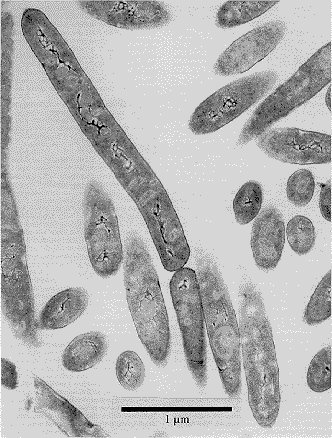
Culture Collections
Subsurface Microbial Culture Collection (SMCC)
The SMCC was established in 1986 to preserve cultures of microorganisms isolated from terrestrial subsurface environments by researchers affiliated with DOE's Deep Microbiology Program. It now contains over 9,500 strains of microbes from sediments and rocks ranging in depth from 20 to 2,800 meters below land surface. The SMCC also maintains databases with detailed information on the cultures and the environments from which they came. Cultures and data retrieval services are available to interested parties in academia, government, and the private sector.
The SMCC strains were retrieved from a variety of previously uncharacterized deep sediments (e.g., aquifer sands, paleosols, and lacustrine sediments) and lithologies (e.g., volcanic tuffs and basalts) by using specialized aseptic drilling protocols, tracer technologies, and sample-handling methods. Approximately 97% of the microbes in the SMCC are bacteria, whereas the rest are fungi. Most of the bacteria are aerobic or facultatively anaerobic organisms with oxidative rather than fermentative metabolic characteristics.
Except for cultural, morphological, and selected physiological traits (information included in the databases), the majority of the bacteria in the SMCC have not been characterized. However, a concerted effort to characterize selected portions of the collection by phylogenetic analysis of 16S ribosomal RNA gene sequences was initiated in 1993. This effort has focused on three groups of isolates: (i) aerobic chemoheterotrophs from Atlantic coastal plain sediments (aquifer sands and clay confining zones) beneath DOE's Savannah River Site (in Aiken, SC); (ii) aerobic chemoheterotrophs from saturated sediments (lacustrine sediments, paleosols, and fluvial sands and gravels) beneath DOE's Hanford Site (in Richland, WA); and (iii) anaerobic bacteria from deep Taylorsville Triassic Basin shales at a site in Virginia. These isolates have proven to be quite diverse, falling into at least 38 genera within six major phylogenetic/taxonomic groups. The most frequently seen Gram-positive genera were Arthrobacter, Bacillus, Micrococcus, and Streptomyces . The most frequently seen Gram-negative genera were Acinetobacter, Comamonas, Pseudomonas, and Sphingomonas.

|
The novel bacterium, Bacillus infernus, from the deep terrestrial subsurface.
|
Most of the approximately 400 SMCC strains characterized so far fall into previously described genera of bacteria. However, many of the strains appear to represent new species within those genera. The most spectacular example of this is Bacillus infernus (the "bacillus from hell"), an obligate anaerobe (new species) that was isolated from a depth of about 2,800 meters below land surface. This is the first known strictly anaerobic member of the genus Bacillus, which has always been described as aerobic. Some of the new species found within the SMCC also have potentially useful metabolic capabilities. For example, a group of strains representing three new species of Sphingomonas (S. aromaticivorans, S. subterranea, and S. stygia) can degrade a variety of aromatic compounds such as naphthaline, xyline, and cresol.
Aerobic strains held by SMCC are stored at Florida State University, Tallahassee, Florida (contact David Balkwill at balkwill@bio.fsu.edu). The strict anaerobes are held at the Oregon Graduate Institute of Science and Technology, Portland, Oregon (contact David Boone at boone@ese.ogi.edu). These anaerobes are listed on the SMCC Web page and can be ordered electronically. An information packet and spreadsheets describing the strains characterized by 16S sequencing can be obtained by contacting David Balkwill at balkwill@bio.fsu.edu.
[Back to Other Related Field Activities]

